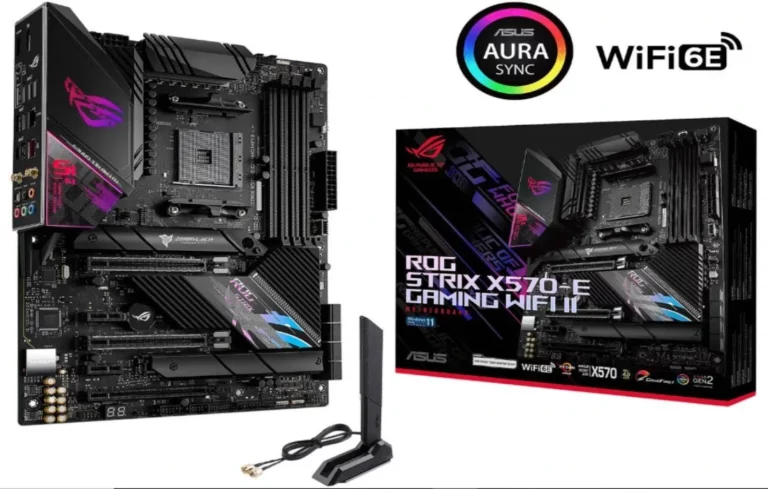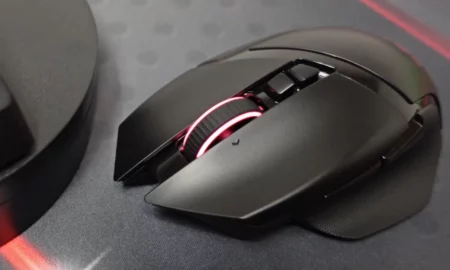If you want to get something out of your AMD Ryzen 3000 or 5000 family Processors, you’d like to check out the top AMD X570 motherboards. Thanks to AMD’s X570 chip, the board features two PCIe 4.0 x4-capable M.2 slots and eight back USB 3.2 Gen 2 jacks. If you don’t like to use built-in Intel’s Wi-Fi 6 AX200, ASUS has you covered with a Realtek RTL8125 LAN controller, which can deliver speeds of up to 2.5Gbps.
ASUS ROG Strix X570-E Gaming Specs
| Size | ATX |
| CPU | AMD Ryzen 3000 AMD Ryzen 5000 |
| Socket | AM4 |
| RAM | 4x DDR4 DIMM (up to DDR4 4400), 128GB limit |
| Chipset | AMD X570 |
| Expansion | 1x PCIe 4.0 x16 (max x4) 2x PCIe 4.0 x16 (x16 or dual x8) 2x PCIe 4.0 x1 |
| Storage | 8x SATA (6Gbps) 2x M.2 (PCIe 4.0 x4/SATA SSD support) |
| Audio | SupremeFX S1220A |
| Rear ports | USB BIOS FlashBack Button(s) 1x 2.5G LAN 1x ASUS Wi-Fi 7x USB-A 3.2 Gen 2 (up to 10Gbps) 1x USB-C 3.2 Gen 2 (up to 10Gbps) 1x DisplayPort 1x HDMI 1x Optical S/PDIF out 5x Audio jack(s) |
| NVIDIA SLI | – |
| AMD CrossFire | ✓ |
The I/O panel should not have eight 10Gbps USB ports. Instead, why are ASUS competitors (particularly MSI MEG, Gigabyte, and ASRock) swapping some of their USB 3.x ports with 5Gbps hubs, given that all the ports included in the X570 system are capable of that bandwidth? Who’d trade one of its rival’s 3 M.2 slots instead of four SATA ports? ASUS ROG Strix X570-E Gaming is the best choice if that’s what you want.
Somewhere between the TUF Gaming X570-Plus and the ROG Crosshair VIII Hero, the motherboard offers great strength despite the fanatic cost overflow of many of the most high-end gaming PC prices. You can get this board for $329 at the time of this writing.
Motherboard designers tend to go with the safest bets when it comes to selecting components. Because of AMD’s announcement that its current framework could endorse one NVMe M.2 drive from the Chipset, as well as up to 16 fast connections from the X570 PCH, that was pretty clear that many vendors would use 12 PCH lanes to implement a 2nd and 3rd M.2 interface and an extra PCIe x4 port. After that, it was up to the manufacturers to decide if the remaining four connections would be used for SATA, USB3, or even more PCIe. As a result, one interface goes disabled in order to operate others. Though ROG Strix X570-E takes a different approach with just two M.2 sockets overall.
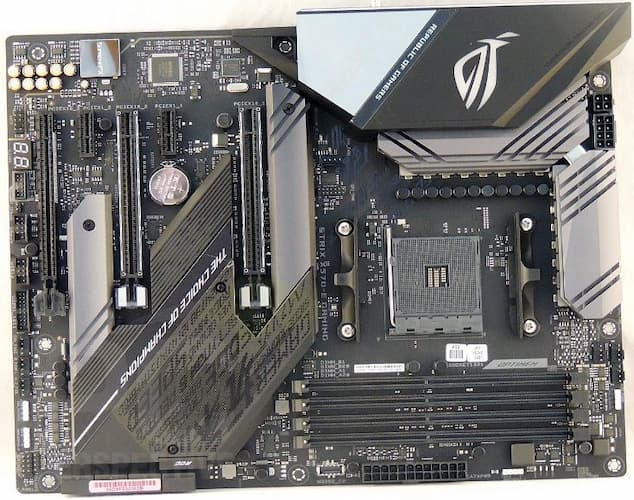
This board is compatible with a wide range of AMD Ryzen processors. You can still use a Ryzen 3000 lineup CPU after installing a Ryzen 5000 support flash because AMD has used the same AM4 port in all of its Ryzen processor builds. It’s the best motherboard for Ryzen 5 3600 processors with the necessary cables to support PCIe 4.0. To get the most out of an X570 of such quality, you’ll need one of the PCIe 4.0 SSDs. Don’t waste your money on an expensive X470 or B450.
Other versions have reduced the number of SATA connectors to four to make PCIe channels. However, the Strix X570-E Gaming offers eight. To make matters worse, while the second x1 PCIe slot is in use, the third x16-length slot is reduced to x2 mode which means you’re left with only two lanes. With its placement, it will not be convenient to use for many users; even that leads people to ask why it’s there in the first place.
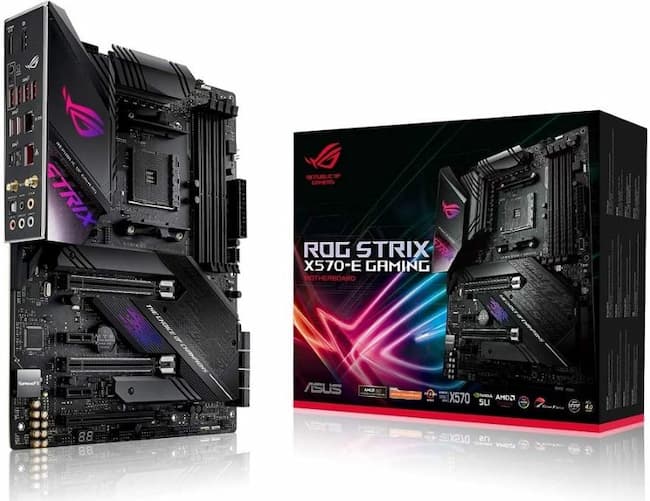
With eight USB3 Gen2 connections on the I/O interface, ASUS intends to take things in stride. Assuming that the USB3 terminals on the system are Gen2 compatible, Gen1 ports serve no purpose anymore. However, many Asus rivals have decided to reduce their I/O. We wanted to see a couple of USB 2.0 connectors to attach the external mouse and keyboard.
Our familiarity with and appreciation for black PCBs stems from their motherboard appearance. A handbook, the essential ASUS Wi-Fi elements, and a few connectors are included in the package alongside the ASUS ROG Strix X570-E Gaming ATX motherboard. It’s best to use two M.2 SSDs via SATA connections for quality in storage capacity.
The 8+4-pin ATX links to power up the CPU are at the top-left corner of the main PCB. There is no need for a second 4-pin connector for excessive overclocking purposes. Three CPU and AIO cooling fan headers and the first of three RGB color headers round off the top of the board.
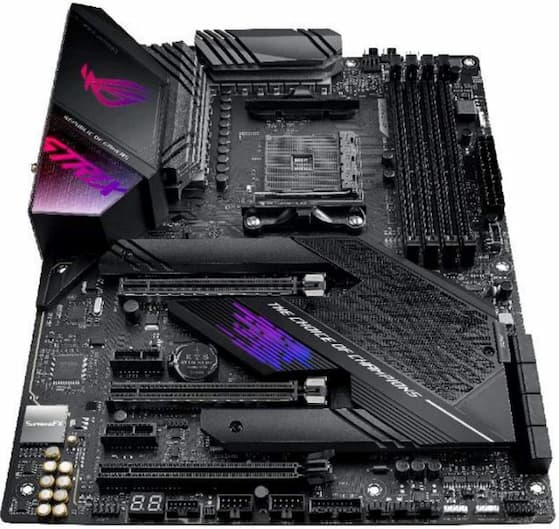
The Strix X570-E motherboard is built with gaming and performance in mind. It has 16 powerful MOSFETs arranged in a 12+4 setup, providing up to 600 amps of power to the processor—a solid choice for overclocking. To keep the system cool, there are three 4-pin fan headers located at the top, bottom, and near the I/O panel’s audio ports. You’ll also find RGB and ARGB headers at the top and bottom for customizable lighting.
At the bottom of the board, there’s a mesh cover over the chipset (PCH) held in place by two supports. If you want to access the M.2 drive slots under the heat spreaders, you’ll need to lift this cover to get to the front screws. However, if you’re not using heat spreaders, the PCH fan cover doesn’t need to be removed to access the M.2 slots.
The Strix X570-E’s attractiveness is undeniable, thanks to the abundance of high-quality features. It’s a good pick to get a reliable PCIe 4.0 board that balances performance and cost. That said, it’s not drastically different from alternatives like the MSI X570 ACE or the Crosshair VIII Hero. While PCIe 4.0 sounds great on paper, it doesn’t make a big difference for gaming. In short, the Strix X570-E is a high-technology motherboard with a clean and understated design. It’s made for gamers and anyone who wants advanced features without breaking the bank.


